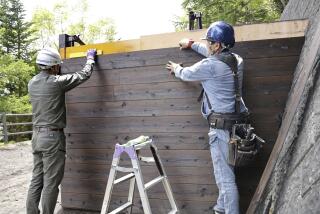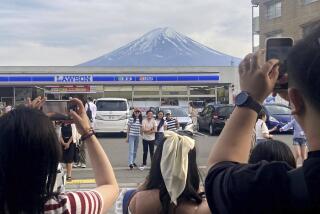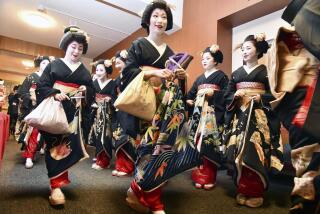The Start of Obon Season Puts Many Japanese in a Jam
- Share via
TOYODA, Japan — The mother of all traffic jams is underway here as millions of Japanese motorists creep out of the major cities in an annual ritual that would challenge even Southern California’s jaded drivers.
The exodus peaked Thursday, with traffic jams up to 34 miles long reported on all four of the major expressways leading out of Tokyo.
It is Obon season in Japan, a time when city dwellers traditionally return to their hometowns in the countryside to worship their ancestors, tend family graves and visit relatives. Although not every Japanese family observes these rituals, and different regions celebrate Obon on different days, the peak period this year is Aug. 13 through 16.
In traditional clans, even Tokyo-born youngsters are expected to show up at the family grave site. And millions of urbanites who no longer have rural roots and who would love to vacation at another time find that their bosses, customers or co-workers make it hard for them to schedule their holiday outside of the maddening crunch period--when air fares double, trains are packed, and the highways present an infinite vista of simmering steel.
“Why does everyone have to go the same direction on the same day, I wonder? Isn’t there anywhere else for us to go?” Kaoru Yamamoto, 38, said with a sigh after pulling over to the Ishikawa rest stop to recover after spending three hours in bumper-to-bumper traffic on her way from a north Tokyo suburb to Mt. Fuji.
By 8 a.m., the backup along the Chuo Expressway leading west out of Tokyo was already 31 miles long, and it took four hours to travel one 35-mile stretch, highway officials said.
By 9:30 a.m., overheated motorists, some with whining children or panting pets in tow, were lining up at the rest stop to buy cold drinks, ice cream, octopus dumplings and other pick-me-ups.
With the mercury hitting 86 degrees and humidity at 75%, many preferred to stay inside their air-conditioned cars, which only occasionally achieved top cruising speed of 10 mph.
The traffic jams are so bad that some motorists carry portable toilets in case of emergency, even though most Japanese are too embarrassed to use them, according to a department store clerk. Coolers, portable massagers and mentholated forehead patches and other products to keep drivers awake are also popular.
This year’s traffic appears to be no more miserable than usual, said Yasutaka Tanaka, spokesman for the Japanese Highway Corp. The worst jam recorded, on Aug. 11, 1995, was an 80-mile-long jam that took 50 hours to clear up, he said.
Japan’s biting recession is keeping many travelers at home this summer. The number of international travelers is expected to drop to 3.1 million, down 2.4% compared with last summer--the first decline since an oil crisis 18 years ago--while domestic travelers will increase by 1.4%, according to Japan Travel Bureau, the nation’s largest travel agency. Japanese media report that some offices and factories are shutting down for extra vacation days this season to save money.
In another sign of tougher times, Japan Rail reported that train reservations for the Obon period were down 3% from last year. Nevertheless, highway officials said there appeared to be no noticeable change in the level of holiday automobile traffic, still the cheapest way for a family to travel in Japan.
Although many employers have become slightly more flexible in allowing workers to stagger their summer holidays, travelers Thursday bemoaned the national penchant for Japanese to take holidays at the same time.
“It’s very difficult for me to take time off at any other time of year,” complained Naomi Yokoyama, a 28-year-old construction company worker who had been sitting in traffic for three hours. “It’s not just the boss, it’s the atmosphere around you. If you take time off, you’ll get cold looks, and your working environment could become more difficult.”
“This is when the boss plans to take off, so you have to take off at the same time,” Koichi Iwatate, 31, explained with a shrug of good-humored resignation.
Motoharu Taniguchi, an official with the Japan Highway Services Assn., said that drivers could avoid the worst traffic by leaving Tokyo in the late afternoon or evening but that they still prefer to engage in an early-morning stampede. Some young people, born and bred in choking traffic, actually enjoy the bumper-to-bumper treks, he insisted.
“They feel like if they’re not in a traffic jam, it’s not really a vacation,” Taniguchi said.
More to Read
Sign up for Essential California
The most important California stories and recommendations in your inbox every morning.
You may occasionally receive promotional content from the Los Angeles Times.













